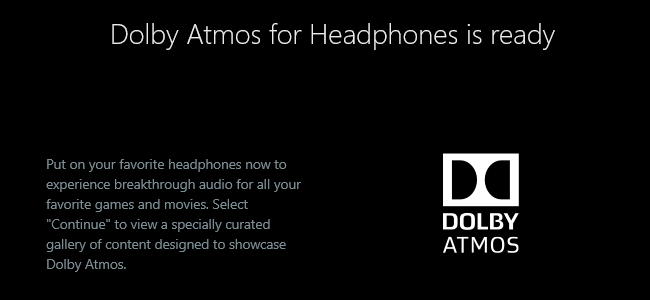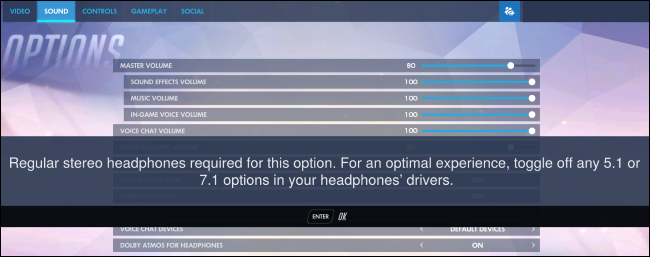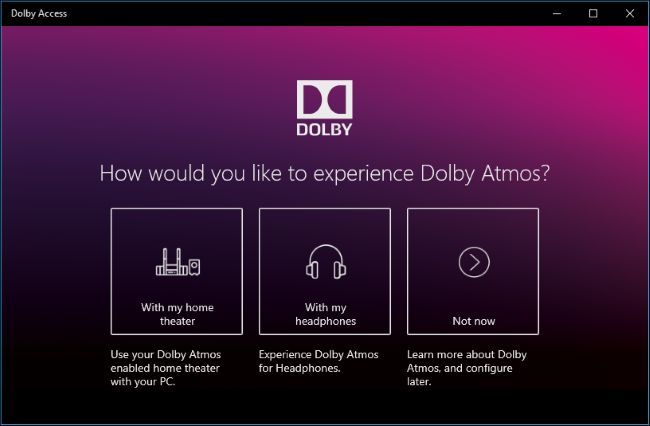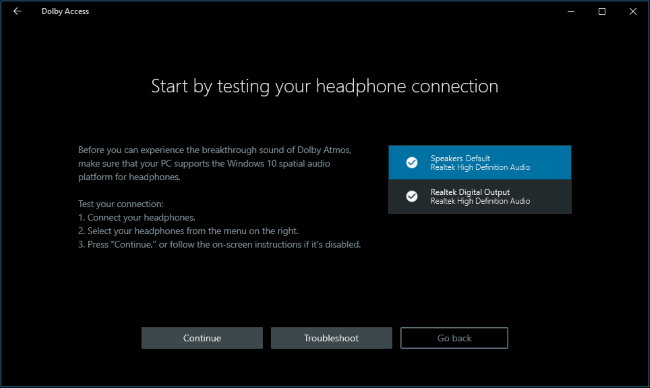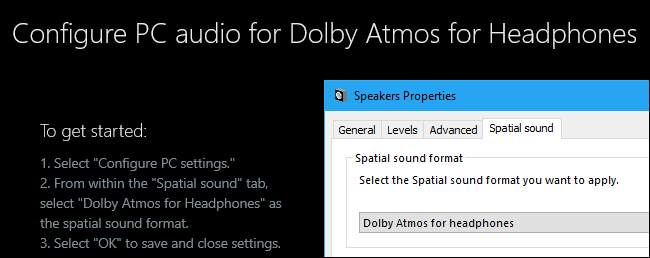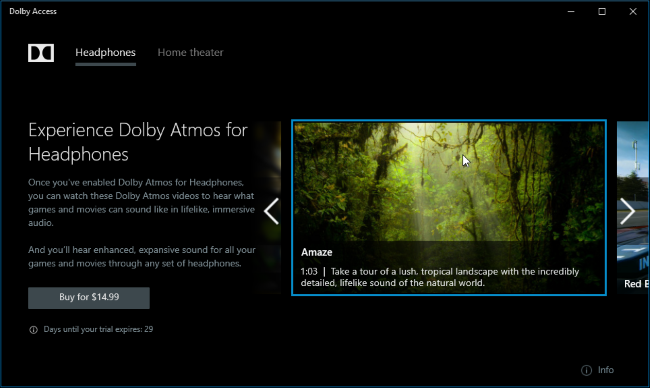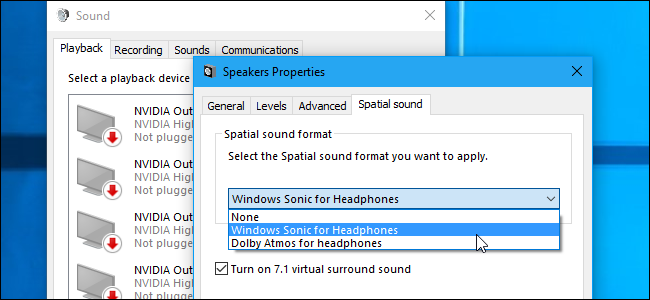Quick Links
Windows 10's Creators Update added support for Dolby Atmos positional sound. This includes two things: Support for Dolby Atmos hardware and virtual Dolby Atmos sound that works in any pair of headphones.
The Dolby Atmos for headphones feature is a bit weird. It appears in the standard Windows control panel as an option, but it requires a free trial or $14.99 purchase via the Windows Store before you can actually use it.
What Is Dolby Atmos?
Traditional 5.1 or 7.1 surround sound uses 5 or 7 speaker channels, plus a subwoofer. When you watch a movie or play a game with surround sound, that movie or game is actually sending 6 or 8 separate channels of sound to your speakers.
Dolby Atmos is an improved type of surround sound. It isn't mixed into several separate channels; instead, sounds are mapped to virtual locations in 3D space, and that spatial data is sent to your speaker system. A Dolby Atmos-enabled receiver then uses specially calibrated speakers to position these sounds. Dolby Atmos systems may include ceiling-mounted speakers above you or speakers on the floor that bounce their sound off the ceiling, for example.
This feature requires Dolby Atmos-enabled hardware, notably a Dolby Atmos-enabled receiver. Microsoft also just added Dolby Atmos support to the Xbox One, and many Blu-ray discs include Dolby Atmos audio.
Windows 10's Creators Update also added a separate feature named "Dolby Atmos for headphones". This feature promises improved positional audio in any pair of headphones or earbuds. You don't need special Dolby Atmos headphones. It's a type of virtual surround sound built into Windows.
Really, this is a completely different feature that's only linked by Dolby's branding. True Dolby Atmos requires a hardware receiver and special speaker setup, while Dolby Atmos for headphones is a digital signal processor (DSP) that takes surround sound from your PC and mixes it to offer an improved positional sound experience in headphones.
Some games have already added support for Dolby Atmos for headphones. For example, Blizzard's Overwatch includes built-in Dolby Atmos support, and it works even if you're not running Windows 10's Creators Update. You can enable this feature from Options > Sound > Dolby Atmos for Headphones in Overwatch. Blizzard argues that Atmos offers an improved experience that allows you to more easily pinpoint where sounds are coming from in the game.
How to Enable Dolby Atmos on Windows 10
To start using this feature, download the Dolby Access app from the Windows Store and launch it.
The app will guide you through setting this up. If you have Dolby Atmos receiver you want to use with your PC, select "With my home theater". If you want to use any pair of headphones, select "With my headphones".
If you select a home theater PC, you'll be given a link to enable the "Dolby Atmos for home theater" option in the Windows Sound settings control panel. After you do, the app will prompt you to calibrate your system. There's no additional purchase necessary for the home theater option---you just need the hardware.
If you select headphones, you'll be prompted to confirm your PC's sound hardware supports the Windows 10 spatial audio platform for headphones. Modern PCs should have sound drivers that support this feature, but you may be out of luck if you have a much older PC you've upgraded to Windows 10.
The Dolby Atmos for headphones feature isn't free. While Microsoft integrated it into Windows, Microsoft clearly didn't pay the licensing fees to allow any Windows user to use it.
You can still try Dolby Atmos for headphones for free, however. Click the "30-day trial" button to enable it.
Once you've enabled the free trial, you'll be prompted to enable Dolby Atmos for headphones. Click the "Configure PC settings" button and then select "Dolby Atmos for headphones" in the Spatial sound format box.
This option actually appears in the properties window for your audio device even if you don't have the Dolby app installed. However, if you try to enable this feature without installing the app first, Windows will prompt you to install the Dolby Access app from the Windows Store first.
How to Test Dolby Atmos
The Dolby Access app will allow you to test Dolby Atmos by playing a variety of videos that support Dolby Atmos audio.
While the videos are impressive enough, you'll want to actually test Dolby Atmos by playing some PC games or watching some surround sound-enabled videos before paying for it and see if you can notice an appreciable difference. Some people say they notice an improvement, while others don't notice much of a difference. It likely depends on the games you're playing videos you're watching, too.
When testing Dolby Atmos, be sure to enable 5.1 or 7.1 surround sound in whatever game or application you use. The application will then produce surround sound, and Dolby Atmos will mix it to stereo sound for your headset.
You're free to test Dolby Atmos for 30 days, after which it will cost $14.99 to buy Dolby Atmos for headphones support from the Windows Store.
How to Try Microsoft's Free Alternative, Windows Sonic for Headphones
Windows 10's Creators Update also offers a free "Windows Sonic for Headphones" option you can enable instead of Dolby Atmos. Just right-click the speaker icon in your system tray, select "Playback Devices", click your playback device, and click "Properties". On the Spatial sound tab, select "Windows Sonic for Headphones".
You may want to test this feature to see how it compares to Dolby Atmos for Headphones in your games and videos. We've seen some people say it doesn't work quite as well as the Dolby Atmos option in their experience, but we've also seen some people say they don't notice much of a difference.
When it comes to sound, everyone often has their own opinion. Audio quality can be very subjective.

